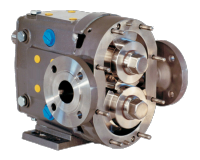Starch, clay and other slurries made up of fine particles become dilatant when they reach a certain concentration. The percentage at which the slurries become dilatant is product specific. Starch slurries generally become dilatant at 4%w/w solids and some coating slurries become dilatant at around 70%w/w solids.
This has considerable implications when trying to pump a near dilatant fluid. A relatively low concentration of starch slurry that is allowed to settle in a pump will become dilatant, binding the pump when it has to start up again. Many types of slurry beside starch will become dilatant, but do so at varying concentrations.
Typically, wet end starch has a concentration of 1-4%, with the actual percentage depending on the paper grade, specific machine application and the desired result. There is an optimal dosage for each application and each paper grade. Pumping more than the required amount wastes starch and contributes to higher costs, whilst pumping less than the required amount reduces the efficiency of the paper making process and may change the properties of the paper. In addition, should the wet end starch system fail, then the paper making machines will shut down very quickly because the sheet will break.
What all this means is that great care and consideration has to be given to choosing the most appropriate type of pump for handling dilatant (or thixotropic) fluids. Two types of pump that are associated with handling slurries in the paper and pulp industry are progressing cavity and rotary lobe pumps. There is an alternative however, this being the Waukesha Cherry Burrell Universal SPU2 pump, which has been developed specifically for the paper and pulp industry.

Waukesha Cherry Burrell Universal SPU2 pump
The Universal SPU2 is a rotary pump that employs an operating principle known as the external circumferential piston (ECP). In this design the arc-shaped rotary pistons, or rotor wings, travel in annular-shaped cylinders machined in the pump body. The resulting long sealing path reduces slippage and produces a smooth product flow without destructive pulses or pressure peaks, and without the need for valves or complex parts. However, unlike progressing cavity and rotary lobe pumps, the Universal SPU2 is not adversely affected by dilatant slurries even when they settle in the pump.
Where high viscosity fluids and solids are involved, the large fluid cavities of the rotors, together with the large easy-entry anti-cavitation ports enable efficient pumping. Maximum service life even under severe operating conditions where fluids are non-lubricating or abrasive can be achieved, because there is no contact between the bearings and the pumped fluid, nor is there sliding or rolling contact and rotor-to-rotor contact.
In a test set up to compare a typical progressing cavity pump, a lobe pump and the Waukesha ECP pump, three bases of comparison were used: pulsation created by the pumps, each pump’s ability to handle near dilatant slurries and the horsepower needed to start the pump after the slurry was allowed to settle and become dilatant. Although kW may not be a major consideration, it does give an indication of the stress placed on the pump when it is in a locked rotor condition created by dilatant slurry.
For the test a 50% slurry was used. All three pumps were connected to the same supply vessel and each pump had approximately the same capacity. The pump speed was adjusted so that the flow and back pressure was comparable for each pump. First the pulsation test was run and this revealed that the pulsation was greatest with the lobe pump, with the progressing cavity pump being next and the ECP pump giving the smoothest flow. Even when the viscosity increases, the Waukesha ECP pump maintains its advantage.
Next, the three pumps were allowed to sit idle for 1.5 hours without being flushed out. In a normal process situation slurries are flushed out before pump shutdown. However, it is inevitable that pumps will shutdown unexpectedly and be restarted at some later time, often after the slurry has settled. This is a key reason why high maintenance costs are experienced with progressing cavity and lobe pumps. The pumps were then restarted: each pump had a 2.2kW motor and a 15kW variable frequency drive, the larger drive allowing pump start-up even with a locked rotor. In the case of the progressing cavity pump, the kW required was 13.5, while the lobe pump required 3kW and took some 15 seconds to gain maximum speed. The ECP pump took less than 1.5kW and reached maximum speed in less than two seconds (Fig.2).
Because the rotors of the SPU2 Series ECP pump produce a scooping action, they do not squeeze and compact the slurry and exaggerate the situation like the progressing cavity and lobe pumps. The scooping action ensures that the dilatant slurry that has settled in the pump is quickly and efficiently removed, with little or no stress on the pump.
In both test and full industry conditions, the external circumferential piston pump has demonstrated significant advantages when handling wet end starch, hot cooked starch, size press starch, coatings and waste matter. Where higher temperatures and pressures are encountered, the Waukesha SPU2 will handle product up to 300oC and 450psi. And if the mechanical seal is flushed out, the pump can run dry indefinitely as there is internal contact.


